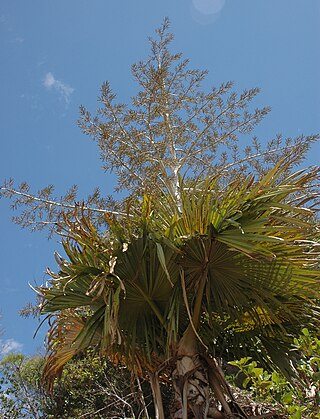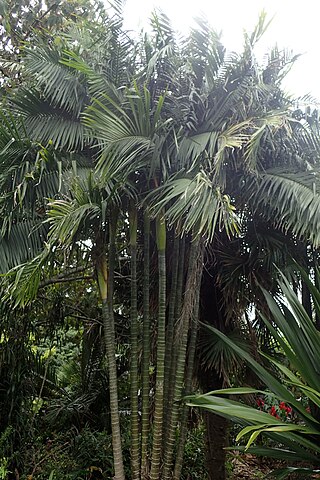
Dypsis lutescens, also known as golden cane palm, areca palm, yellow palm, butterfly palm, or bamboo palm, is a species of flowering plant in the family Arecaceae, native to Madagascar and naturalized in the Andaman Islands, Thailand, Vietnam, Réunion, El Salvador, Cuba, Puerto Rico, the Canary Islands, southern Florida, Haiti, the Dominican Republic, Jamaica, the Leeward Islands and the Leeward Antilles. Its native names are rehazo and lafahazo.

Dypsis decaryi is a species of flowering plant in the Arecaceae family. It is commonly known as the triangle palm. It is indigenous to the Madagascan rainforest. Some specimens grow to a height of some 15 metres (49 ft) in the wild. It is relatively new to cultivation however, so outside its native habitat it rarely achieves anything like that height. The leaves are about 2.5 metres in length, growing almost upright from the trunk and arching gracefully outward about a metre from their tips. The leaf bases are arranged in three vertical columns set about 120 degrees apart on the main stem, forming a triangular shape in cross section. This shape has given rise to the palm's common name.
Dypsis antanambensis is a species of flowering plant in the Arecaceae family. It is a palm endemic to Madagascar, where it grows in rainforests. The whole population occurs within Mananara-Nord National Park and there are fewer than 50 mature individuals estimated to remain.
Dypsis bejofo is a species of flowering plant in the Arecaceae family. It is a palm endemic to Madagascar. It grows on hilltops and slopes in rainforest habitat. The species is threatened by overcollection of seeds and by habitat loss. There may be only about 300 mature individuals remaining. Some grow in protected areas.
Dypsis canaliculata is a species of flowering plant in the family Arecaceae. It is found only in Madagascar, where it is thought that fewer than 10 individual plants exist. It was previously collected from two disjunct populations, one in Manongarivo and one in Ampasimanolotra. Both were growing on sandstone in lowland forest regions. In 2001 another small population was discovered in Zahamena National Park, and this is now the only known surviving group. To date no flowers from D. canaliculata have ever been collected for science.
Dypsis canescens, also known as Chrysalidocarpus canescens, is a species of flowering plant in the family Arecaceae. It is endemic to the Sambirano region of northwestern Madagascar. It was identified in 1913. It is probably extinct, given that it has not been seen for half a century.

Dypsis decipiens, the Manambe palm, is a species of flowering plant in the Palm family (Arecaceae). It is found only in the central highlands of Madagascar, between Fianarantsoa and Andilamena at 1,200 to 1,700 meters elevation. The species is threatened by habitat loss, increasing frequency of fires, and over-exploitation of its seeds for the horticultural trade. Its most unique characteristic is that it commonly produces twin trunks like the letter "V", each trunk being up to 65 feet in height and up to 28 inches DBH. There can also be three trunks, or a single trunk.
Dypsis dransfieldii is a species of flowering plant in the Arecaceae family. It is a palm endemic to Madagascar that grows on white sands in lowland forest habitat. Populations are protected in Masoala National Park.
Dypsis faneva is a species of flowering plant in the Arecaceae family. It is a palm endemic to Madagascar, where it grows in rainforests. It is threatened by habitat destruction. Fewer than 70 mature individuals are thought to remain.
Dypsis ligulata is a species of flowering plant in the family Arecaceae. It is found only in Madagascar. It is threatened by habitat loss.

Dypsis madagascariensis is a species of flowering plant in the family Arecaceae. It is found only in Madagascar. It is threatened by habitat loss.
Dypsis nauseosa is a species of flowering plant in the family Arecaceae. It is found only in Madagascar. It is threatened by habitat loss.
Dypsis onilahensis is a species of palm tree in the family Arecaceae. It is endemic to Madagascar as is reflected in the species name (onilahensis) referring to the Onilahy River, south of Toliara. It is threatened by habitat loss.
Dypsis singularis is a species of flowering plant in the Palm Family. It is found only on the island of Madagascar. It is threatened by habitat loss. It is remarkable for its height to width ratio; the greatest of any tree. It is up to 19ft 8in tall while being only 2/5ths of a inch in diameter, a length/width ratio of 600 fold.
Dypsis tsaravoasira is a species of flowering plant in the Arecaceae family. It is a palm endemic to Madagascar, where it grows in rainforests. There are perhaps 500 plants remaining, and the population is decreasing due to overharvest.

Tahina spectabilis, the tahina palm, also called blessed palm or dimaka is a species of gigantic palm that is found only in the Analalava District of northwestern Madagascar where its range is only twelve acres, one of the most extreme examples of endemism known. It can grow 18 m (59 ft) tall and has palmate leaves over 5 m (16 ft) across. The trunk is up to 20 in (51 cm) thick, and sculpted with conspicuous leaf scars. An individual tree was discovered when in flower in 2007; it was first described the following year as a result of photographs being sent to Kew Gardens in the United Kingdom for identification. The palm is thought to live for up to fifty years before producing an enormous inflorescence up to 19.5 ft (5.9 m) in height and width, surpassed in size only by Corypha spp. and by Metroxylon salomonense and, being monocarpic, subsequently dying. The inflorescence, a panicle, consists of hundreds, perhaps thousands, of three-flowered clusters which bloom in three consecutive, synchronized "cohorts" or flushes of bloom. The nearest equivalent pattern of flowering is in the flowering vine Bougainvillea where the three flowers bloom sequentially, but not synchronized. Fewer than one hundred adult individuals of the species are thought to exist and the International Union for Conservation of Nature has rated it as "critically endangered".
Dypsis brevicaulis is a species of flowering plant in the Arecaceae family. It is a dwarf palm found on only three sites in Madagascar, with fewer than fifty plants ever found in the wild. The plant is part of the IUCN Sampled Red List Index for Plants, a study of representative species from all over the world which is studying extinction trends for plants.

Chuniophoeniceae is a tribe of palms in subfamily Coryphoideae of plant family Arecaceae. The four genera within the tribe are morphologically dissimilar and do not have overlapping distributions. Three of the genera are monotypic, while the fourth genus (Chuniophoenix) has three species.

Dypsis baronii is a species of palm tree in the family Arecaceae. It is otherwise known as "sugarcane palm" because of the scars on its trunks that resemble sugarcane.
Dypsis beentjei is an acaulescent flowering plant belonging to the family of palm trees, Arecaceae.







